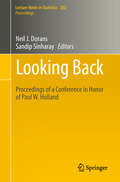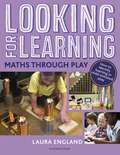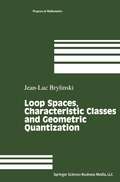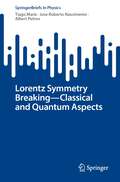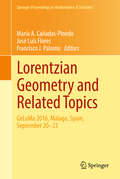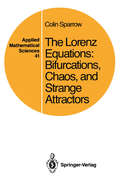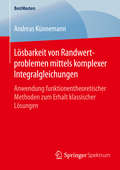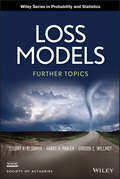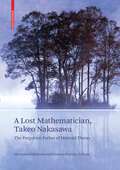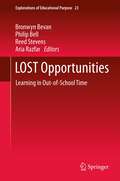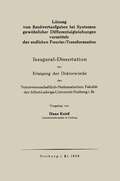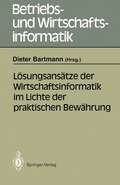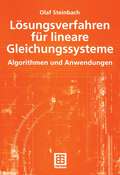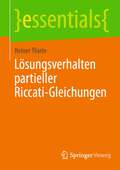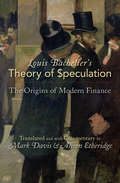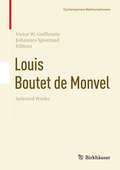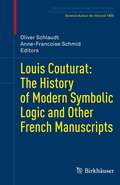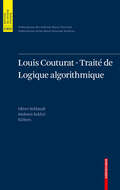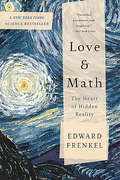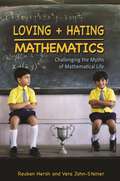- Table View
- List View
Looking Back: Proceedings of a Conference in Honor of Paul W. Holland (Lecture Notes in Statistics #202)
by Neil J. Dorans and Sandip SinharayIn 2006, Paul W. Holland retired from Educational Testing Service (ETS) after a career spanning five decades. In 2008, ETS sponsored a conference, Looking Back, honoring his contributions to applied and theoretical psychometrics and statistics. Looking Back attracted a large audience that came to pay homage to Paul Holland and to hear presentations by colleagues who worked with him in special ways over those 40+ years. This book contains papers based on these presentations, as well as vignettes provided by Paul Holland before each section.The papers in this book attest to how Paul Holland's pioneering ideas influenced and continue to influence several fields such as social networks, causal inference, item response theory, equating, and DIF. He applied statistical thinking to a broad range of ETS activities in test development, statistical analysis, test security, and operations. The original papers contained in this book provide historical context for Paul Holland’s work alongside commentary on some of his major contributions by noteworthy statisticians working today.
Looking for Learning: Maths through Play
by Laura EnglandLooking for Learning: Maths through Play is a full-colour, practical guide to encourage children to think about maths while playing, using a range of common resources that will spark their curiosity. It is full of creative suggestions for incorporating mathematical concepts – counting, comparison, composition, shape, pattern and number – into child-led play. The book contains ideas for bringing mathematical learning into children's favourite activities: role play and construction; art and nature; sand and water play and even simple technology-based activities using projectors or torches. Experienced Early Years teacher Laura England, creator of Little Miss Early Years, also provides advice about getting children talking about maths during daily routines in Early Years settings. This dip-in-and-out book is linked to the Characteristics of Effective Learning and presents case studies, real-life images and practical pointers on how to use play for early mathematical concepts. With tips from setting up the environment to the adult's role in this child-led play, Looking for Learning: Maths through Play is ideal for all Early Years practitioners searching for accessible ideas for incorporating the mathematical learning through play into their settings.Looking for Learning books are the number one tool for identifying learning opportunities in child-led play. All four books are packed full of tried-and-tested ideas for indoor and outdoor activities, helpful hints and tips and full-colour photographs. Written by Laura England, known as Little Miss Early Years, these are a must-have for any nursery or pre-school.
Looking for Learning: Maths through Play
by Laura EnglandLooking for Learning: Maths through Play is a full-colour, practical guide to encourage children to think about maths while playing, using a range of common resources that will spark their curiosity. It is full of creative suggestions for incorporating mathematical concepts – counting, comparison, composition, shape, pattern and number – into child-led play. The book contains ideas for bringing mathematical learning into children's favourite activities: role play and construction; art and nature; sand and water play and even simple technology-based activities using projectors or torches. Experienced Early Years teacher Laura England, creator of Little Miss Early Years, also provides advice about getting children talking about maths during daily routines in Early Years settings. This dip-in-and-out book is linked to the Characteristics of Effective Learning and presents case studies, real-life images and practical pointers on how to use play for early mathematical concepts. With tips from setting up the environment to the adult's role in this child-led play, Looking for Learning: Maths through Play is ideal for all Early Years practitioners searching for accessible ideas for incorporating the mathematical learning through play into their settings.Looking for Learning books are the number one tool for identifying learning opportunities in child-led play. All four books are packed full of tried-and-tested ideas for indoor and outdoor activities, helpful hints and tips and full-colour photographs. Written by Laura England, known as Little Miss Early Years, these are a must-have for any nursery or pre-school.
Loop Spaces, Characteristic Classes and Geometric Quantization (Modern Birkhäuser Classics Ser.)
by Jean-Luc BrylinskiThis book examines the differential geometry of manifolds, loop spaces, line bundles and groupoids, and the relations of this geometry to mathematical physics. Applications presented in the book involve anomaly line bundles on loop spaces and anomaly functionals, central extensions of loop groups, Kähler geometry of the space of knots, and Cheeger--Chern--Simons secondary characteristics classes. It also covers the Dirac monopole and Dirac’s quantization of the electrical charge.
Lorentz Symmetry Breaking—Classical and Quantum Aspects (SpringerBriefs in Physics)
by Tiago Mariz Jose Roberto Nascimento Albert PetrovThis book presents a review of various issues related to Lorentz symmetry breaking. Explicitly, we consider (i) motivations for introducing Lorentz symmetry breaking, (ii) classical aspects of Lorentz-breaking field theory models including typical forms of Lorentz-breaking additive terms, wave propagation in Lorentz-breaking theories, and mechanisms for breaking the Lorentz symmetry; (iii) quantum corrections in Lorentz-breaking theories, especially the possibilities for perturbation generating the most interesting Lorentz-breaking terms; (iv) correspondence between non-commutative field theories and Lorentz symmetry breaking; (v) supersymmetric Lorentz-breaking theories; and (vi) Lorentz symmetry breaking in a curved space-time. We close the book with the review of experimental studies of Lorentz symmetry breaking. The importance and relevance of these topics are explained, first, by studies of limits of applicability of the Lorentz symmetry, second, by searches of the possible extensions of the standard model, including the Lorentz-breaking ones, and need to study their properties, third, by the relation between Lorentz symmetry breaking with string theory, fourth, by the problem of formulating a consistent quantum gravity theory, so that various modified gravity models are to be examined.
Lorentzian Geometry and Related Topics: GeLoMa 2016, Málaga, Spain, September 20–23 (Springer Proceedings in Mathematics & Statistics #211)
by María A. Cañadas-Pinedo José Luis Flores Francisco J. PalomoThis volume contains a collection of research papers and useful surveys by experts in the field which provide a representative picture of the current status of this fascinating area. Based on contributions from the VIII International Meeting on Lorentzian Geometry, held at the University of Málaga, Spain, this volume covers topics such as distinguished (maximal, trapped, null, spacelike, constant mean curvature, umbilical...) submanifolds, causal completion of spacetimes, stationary regions and horizons in spacetimes, solitons in semi-Riemannian manifolds, relation between Lorentzian and Finslerian geometries and the oscillator spacetime. In the last decades Lorentzian geometry has experienced a significant impulse, which has transformed it from just a mathematical tool for general relativity to a consolidated branch of differential geometry, interesting in and of itself. Nowadays, this field provides a framework where many different mathematical techniques arise with applications to multiple parts of mathematics and physics. This book is addressed to differential geometers, mathematical physicists and relativists, and graduate students interested in the field.
The Lorenz Equations: Bifurcations, Chaos, and Strange Attractors (Applied Mathematical Sciences #41)
by Colin SparrowThe equations which we are going to study in these notes were first presented in 1963 by E. N. Lorenz. They define a three-dimensional system of ordinary differential equations that depends on three real positive parameters. As we vary the parameters, we change the behaviour of the flow determined by the equations. For some parameter values, numerically computed solutions of the equations oscillate, apparently forever, in the pseudo-random way we now call "chaotic"; this is the main reason for the immense amount of interest generated by the equations in the eighteen years since Lorenz first presented them. In addition, there are some parameter values for which we see "preturbulence", a phenomenon in which trajectories oscillate chaotically for long periods of time before finally settling down to stable stationary or stable periodic behaviour, others in which we see "intermittent chaos", where trajectories alternate be tween chaotic and apparently stable periodic behaviours, and yet others in which we see "noisy periodicity", where trajectories appear chaotic though they stay very close to a non-stable periodic orbit. Though the Lorenz equations were not much studied in the years be tween 1963 and 1975, the number of man, woman, and computer hours spent on them in recent years - since they came to the general attention of mathematicians and other researchers - must be truly immense.
Lösbarkeit von Randwertproblemen mittels komplexer Integralgleichungen: Anwendung funktionentheoretischer Methoden zum Erhalt klassischer Lösungen (BestMasters)
by Andreas KünnemannDen Ideen von I. N. Vekua folgend verknüpft Andreas Künnemann in seiner Arbeit die Frage nach der Lösbarkeit von Randwertproblemen mit Methoden der Funktionentheorie, wobei hier klassische Lösungen im Fokus stehen. Wert gelegt wurde auf eine systematische und nachvollziehbare Gesamtdarstellung der Thematik. Ausgehend von einem reellen Randwertproblem mit allgemeiner Randbedingung wird der Weg hin zu einem komplexen Randwertproblem beschrieben. Dieses wird mithilfe komplexer Integraloperatoren in eine äquivalente Integralgleichung überführt und deren Lösbarkeit im Anschluss untersucht.
Loss Models: Further Topics (Wiley Series in Probability and Statistics #977)
by Stuart A. Klugman Harry H. Panjer Gordon E. WillmotAn essential resource for constructing and analyzing advanced actuarial models Loss Models: Further Topics presents extended coverage of modeling through the use of tools related to risk theory, loss distributions, and survival models. The book uses these methods to construct and evaluate actuarial models in the fields of insurance and business. Providing an advanced study of actuarial methods, the book features extended discussions of risk modeling and risk measures, including Tail-Value-at-Risk. Loss Models: Further Topics contains additional material to accompany the Fourth Edition of Loss Models: From Data to Decisions, such as: Extreme value distributions Coxian and related distributions Mixed Erlang distributions Computational and analytical methods for aggregate claim models Counting processes Compound distributions with time-dependent claim amounts Copula models Continuous time ruin models Interpolation and smoothing The book is an essential reference for practicing actuaries and actuarial researchers who want to go beyond the material required for actuarial qualification. Loss Models: Further Topics is also an excellent resource for graduate students in the actuarial field.
Loss Models: Further Topics (Wiley Series in Probability and Statistics)
by Stuart A. Klugman Harry H. Panjer Gordon E. WillmotAn essential resource for constructing and analyzing advanced actuarial models Loss Models: Further Topics presents extended coverage of modeling through the use of tools related to risk theory, loss distributions, and survival models. The book uses these methods to construct and evaluate actuarial models in the fields of insurance and business. Providing an advanced study of actuarial methods, the book features extended discussions of risk modeling and risk measures, including Tail-Value-at-Risk. Loss Models: Further Topics contains additional material to accompany the Fourth Edition of Loss Models: From Data to Decisions, such as: Extreme value distributions Coxian and related distributions Mixed Erlang distributions Computational and analytical methods for aggregate claim models Counting processes Compound distributions with time-dependent claim amounts Copula models Continuous time ruin models Interpolation and smoothing The book is an essential reference for practicing actuaries and actuarial researchers who want to go beyond the material required for actuarial qualification. Loss Models: Further Topics is also an excellent resource for graduate students in the actuarial field.
Lost Causes in and beyond Physics
by R.F. StreaterThis book deals with a selection of research topics in theoretical physics that have (almost) been proven to be a dead-end or continue at least to be highly controversial. Nevertheless, small but dedicated research communities continue to work on these issues. In a series of essays this book describes their work and struggle as well as the chances of any breakthrough in these areas. It is written as both an entertainment and serious study.
A Lost Mathematician, Takeo Nakasawa: The Forgotten Father of Matroid Theory
by Hirokazu Nishimura Susumu KurodaMatroid theory was invented in the middle of the 1930s by two mathematicians independently, namely, Hassler Whitney in the USA and Takeo Nakasawa in Japan. Whitney became famous, but Nakasawa remained anonymous until two decades ago. He left only four papers to the mathematical community, all of them written in the middle of the 1930s. It was a bad time to have lived in a country that had become as eccentric as possible. Just as Nazism became more and more flamboyant in Europe in the 1930s, Japan became more and more esoteric and fanatical in the same time period. This book explains the little that is known about Nakasawa’s personal life in a Japan that had, among other failures, lost control over its military. This book contains his four papers in German and their English translations as well as some extended commentary on the history of Japan during those years. The book also contains 14 photos of him or his family. Although the veil of mystery surrounding Nakasawa’s life has only been partially lifted, the work presented in this book speaks eloquently of a tragic loss to the mathematical community.
LOST Opportunities: Learning in Out-of-School Time (Explorations of Educational Purpose #23)
by Bronwyn Bevan, Philip Bell, Reed Stevens and Aria RazfarLearning in informal settings is attracting growing attention from policymakers and researchers, yet there remains, at the moment, a dearth of literature on the topic. Thus this volume, which examines how science and mathematics are experienced in everyday and out-of-school-time (OST) settings, makes an important contribution to the field of the learning sciences. Conducting research on OST learning requires us to broaden and deepen our conceptions of learning as well as to better identify the unique and common qualities of different learning settings. We must also find better ways to analyze the interplay between OST and school-based learning. In this volume, scholars develop theoretical structures that are useful not only for understanding learning processes, but also for helping to create and support new opportunities for learning, whether they are in or out of school, or bridging a range of settings. The chapters in this volume include studies of everyday and ‘situated’ processes that facilitate science and mathematics learning. They also feature new theoretical and empirical frameworks for studying learning pathways that span both in- and out-of-school time and settings. Contributors also examine structured OST programs in which everyday and situated modes of learning are leveraged in support of more disciplined practices and conceptions of science and mathematics. Fortifying much of this work is a leading focus on educational equity—a desire to foster more socially supportive and intellectually engaging science and mathematics learning opportunities for youth from historically non-dominant communities. Full of compelling examples and revealing analysis, this book is a vital addition to the literature on a subject with a fast-rising profile.
Lösung von Randwertaufgaben bei Systemen gewöhnlicher Differentialgleichungen vermittels der endlichen Fourier-Transformation: Inaugural-Dissertation zur Erlangung der Doktorwürde der Naturwissenschaftlich-Mathematischen Fakultät der Albert-Ludwigs-Universität Freiburg i. Br.
by Hans KniessDieser Buchtitel ist Teil des Digitalisierungsprojekts Springer Book Archives mit Publikationen, die seit den Anfängen des Verlags von 1842 erschienen sind. Der Verlag stellt mit diesem Archiv Quellen für die historische wie auch die disziplingeschichtliche Forschung zur Verfügung, die jeweils im historischen Kontext betrachtet werden müssen. Dieser Titel erschien in der Zeit vor 1945 und wird daher in seiner zeittypischen politisch-ideologischen Ausrichtung vom Verlag nicht beworben.
Lösungsansätze der Wirtschaftsinformatik im Lichte der praktischen Bewährung (Betriebs- und Wirtschaftsinformatik #51)
by Dieter BartmannLösungsverfahren für lineare Gleichungssysteme: Algorithmen und Anwendungen (Mathematik für Ingenieure und Naturwissenschaftler, Ökonomen und Landwirte)
by Olaf SteinbachDie Simulation technischer Prozesse erfordert in der Regel die Lösung von linearen Gleichungssystemen großer Dimension. Hierfür werden moderne vorkonditionierte Iterationsverfahren (z.B. CG, GMRES, BiCGStab) hergeleitet und die zur Realisierung notwendigen Algorithmen beschrieben. Für Systeme mit strukturierten Matrizen werden effiziente direkte Lösungsverfahren angegeben. Numerische Beispiele für praktische Problemstellungen illustrieren die Effizienz der vorgestellten Verfahren.
Lösungsverhalten partieller Riccati-Gleichungen (essentials)
by Reiner ThieleDas Buch vermittelt Lösungsverfahren für partielle Riccati-Differenzialgleichungen (DGL). Diese DGL appliziert man zur mathematischen Beschreibung der Funktion von Faraday-Effekt-Stromsensoren. Ausgehend vom allgemeinen Lösungsverhalten erfolgt die Definition des individuellen sowie kollektiven Lösungsverhaltens einer beliebigen Gleichung. Reiner Thiele erklärt den Unterschied zwischen Individual- und Partiallösungen. Außerdem kreiert er Simulationsdiagramme und zeigt, dass es sich bei der Hardware um Regelkreise handelt.
Louis Bachelier's Theory of Speculation: The Origins of Modern Finance
by Louis Bachelier Mark Davis Alison Etheridge Paul A. SamuelsonMarch 29, 1900, is considered by many to be the day mathematical finance was born. On that day a French doctoral student, Louis Bachelier, successfully defended his thesis Théorie de la Spéculation at the Sorbonne. The jury, while noting that the topic was "far away from those usually considered by our candidates," appreciated its high degree of originality. This book provides a new translation, with commentary and background, of Bachelier's seminal work. Bachelier's thesis is a remarkable document on two counts. In mathematical terms Bachelier's achievement was to introduce many of the concepts of what is now known as stochastic analysis. His purpose, however, was to give a theory for the valuation of financial options. He came up with a formula that is both correct on its own terms and surprisingly close to the Nobel Prize-winning solution to the option pricing problem by Fischer Black, Myron Scholes, and Robert Merton in 1973, the first decisive advance since 1900. Aside from providing an accurate and accessible translation, this book traces the twin-track intellectual history of stochastic analysis and financial economics, starting with Bachelier in 1900 and ending in the 1980s when the theory of option pricing was substantially complete. The story is a curious one. The economic side of Bachelier's work was ignored until its rediscovery by financial economists more than fifty years later. The results were spectacular: within twenty-five years the whole theory was worked out, and a multibillion-dollar global industry of option trading had emerged.
Louis Bachelier's Theory of Speculation: The Origins of Modern Finance
by Louis Bachelier Mark Davis Alison Etheridge Paul A. SamuelsonMarch 29, 1900, is considered by many to be the day mathematical finance was born. On that day a French doctoral student, Louis Bachelier, successfully defended his thesis Théorie de la Spéculation at the Sorbonne. The jury, while noting that the topic was "far away from those usually considered by our candidates," appreciated its high degree of originality. This book provides a new translation, with commentary and background, of Bachelier's seminal work. Bachelier's thesis is a remarkable document on two counts. In mathematical terms Bachelier's achievement was to introduce many of the concepts of what is now known as stochastic analysis. His purpose, however, was to give a theory for the valuation of financial options. He came up with a formula that is both correct on its own terms and surprisingly close to the Nobel Prize-winning solution to the option pricing problem by Fischer Black, Myron Scholes, and Robert Merton in 1973, the first decisive advance since 1900. Aside from providing an accurate and accessible translation, this book traces the twin-track intellectual history of stochastic analysis and financial economics, starting with Bachelier in 1900 and ending in the 1980s when the theory of option pricing was substantially complete. The story is a curious one. The economic side of Bachelier's work was ignored until its rediscovery by financial economists more than fifty years later. The results were spectacular: within twenty-five years the whole theory was worked out, and a multibillion-dollar global industry of option trading had emerged.
Louis Boutet de Monvel, Selected Works (Contemporary Mathematicians)
by Victor W. Guillemin Johannes SjöstrandThis book features a selection of articles by Louis Boutet de Monvel and presents his contributions to the theory of partial differential equations and analysis. The works selected here reveal his central role in the development of his field, including three cornerstones: firstly, analytic pseudodifferential operators, which have become a fundamental aspect of analytic microlocal analysis, and secondly the Boutet de Monvel calculus for boundary problems for elliptic partial differential operators, which is still an important tool also in index theory. Thirdly, Boutet de Monvel was one of the first people to recognize the importance of the existence of generalized functions, whose singularities are concentrated on a single ray in phase space, which led him to make essential contributions to hypoelliptic operators and to a very successful and influential calculus of Toeplitz operators with applications to spectral and index theory.Other topics treated here include microlocal analysis, star products and deformation quantization as well as problems in several complex variables, index theory and geometric quantization. This book will appeal to both experts in the field and students who are new to this subject.
Louis Couturat: The History of Modern Symbolic Logic and Other French Manuscripts (Publications des Archives Henri Poincaré Publications of the Henri Poincaré Archives)
This volume features a critical edition of the recently rediscovered manuscripts written by the French philosopher Louis Couturat (1868-1914). It includes the transcriptions of three of his believed to be lost manuscripts: first the “Cours de Caen: 1898-99” on various systems of symbolic logic, second his lecture at the Collège de France “Histoire de la logique formelle moderne", and third his textbook on mathematical logic. The manuscripts document the early reception of mathematical logic in France and provide insights into the first introduction of the French reader to the work of Gottlob Frege and Bertrand Russell. It is the aim of the editors of this volume to contribute to the history of symbolic logic, particularly the history of its dissemination and its teaching in France. At the same time, the volume contributes to an alternative history and conception of philosophy in which semiotics and concrete mathematical practice stand in focus. The book is interesting for students and researchers in the history of philosophy, mathematics, and logic.
Louis Couturat -Traité de Logique algorithmique (Publications des Archives Henri Poincaré Publications of the Henri Poincaré Archives)
by Oliver Schlaudt Mohsen SakhriLouis Couturat (1868–1914) was an outstanding intellectual of the turn of the nineteenth to the twentieth century. He is known for his work in the philosophy of mathematics, for his critical and editorial work on Leibniz, for his attempt to popularise modern logic in France, for his commitment to an international auxiliary language, as well as for his extended correspondence with scholars and mathematicians from Great Britain, the United States, Italy, and Germany. From his correspondence we know of four unpublished manuscripts on logic and its history, which were largely complete and some of which must have been of considerable size. We publish here for the ?rst time in a critical edition the only one of these manuscripts that has been rediscovered: the Traité de Logique algorithmique, presumably written in the years 1899–1901. It is a highly interesting document of the academic reception and popularisation of symbolic logic in France. It provides evidence of the discussions and controversies which accompanied the creation of logic as a new branch of science. At the same time it completes the picture of Couturat’s work, which has been opened up to systematic study by the publication of important parts of his correspondence during the last decade. We append the article on Symbolic Logic of 1902 which Couturat wrote in collaboration with Christine Ladd- Franklin for Baldwin’s Dictionary of Philosophy and Psychology.
Love and Math: The Heart of Hidden Reality
by Edward FrenkelAn awesome, globe-spanning, and New York Times bestselling journey through the beauty and power of mathematicsWhat if you had to take an art class in which you were only taught how to paint a fence? What if you were never shown the paintings of van Gogh and Picasso, weren't even told they existed? Alas, this is how math is taught, and so for most of us it becomes the intellectual equivalent of watching paint dry.In Love and Math, renowned mathematician Edward Frenkel reveals a side of math we've never seen, suffused with all the beauty and elegance of a work of art. In this heartfelt and passionate book, Frenkel shows that mathematics, far from occupying a specialist niche, goes to the heart of all matter, uniting us across cultures, time, and space.Love and Math tells two intertwined stories: of the wonders of mathematics and of one young man's journey learning and living it. Having braved a discriminatory educational system to become one of the twenty-first century's leading mathematicians, Frenkel now works on one of the biggest ideas to come out of math in the last 50 years: the Langlands Program. Considered by many to be a Grand Unified Theory of mathematics, the Langlands Program enables researchers to translate findings from one field to another so that they can solve problems, such as Fermat's last theorem, that had seemed intractable before.At its core, Love and Math is a story about accessing a new way of thinking, which can enrich our lives and empower us to better understand the world and our place in it. It is an invitation to discover the magic hidden universe of mathematics.
Love and Math: The Heart of Hidden Reality
by Edward FrenkelAn awesome, globe-spanning, and New York Times bestselling journey through the beauty and power of mathematics What if you had to take an art class in which you were only taught how to paint a fence? What if you were never shown the paintings of van Gogh and Picasso, weren't even told they existed? Alas, this is how math is taught, and so for most of us it becomes the intellectual equivalent of watching paint dry. In Love and Math, renowned mathematician Edward Frenkel reveals a side of math we've never seen, suffused with all the beauty and elegance of a work of art. In this heartfelt and passionate book, Frenkel shows that mathematics, far from occupying a specialist niche, goes to the heart of all matter, uniting us across cultures, time, and space. Love and Math tells two intertwined stories: of the wonders of mathematics and of one young man's journey learning and living it. Having braved a discriminatory educational system to become one of the twenty-first century's leading mathematicians, Frenkel now works on one of the biggest ideas to come out of math in the last 50 years: the Langlands Program. Considered by many to be a Grand Unified Theory of mathematics, the Langlands Program enables researchers to translate findings from one field to another so that they can solve problems, such as Fermat's last theorem, that had seemed intractable before. At its core, Love and Math is a story about accessing a new way of thinking, which can enrich our lives and empower us to better understand the world and our place in it. It is an invitation to discover the magic hidden universe of mathematics.
Loving and Hating Mathematics: Challenging the Myths of Mathematical Life
by Reuben Hersh Vera John-SteinerMathematics is often thought of as the coldest expression of pure reason. But few subjects provoke hotter emotions--and inspire more love and hatred--than mathematics. And although math is frequently idealized as floating above the messiness of human life, its story is nothing if not human; often, it is all too human. Loving and Hating Mathematics is about the hidden human, emotional, and social forces that shape mathematics and affect the experiences of students and mathematicians. Written in a lively, accessible style, and filled with gripping stories and anecdotes, Loving and Hating Mathematics brings home the intense pleasures and pains of mathematical life. These stories challenge many myths, including the notions that mathematics is a solitary pursuit and a "young man's game," the belief that mathematicians are emotionally different from other people, and even the idea that to be a great mathematician it helps to be a little bit crazy. Reuben Hersh and Vera John-Steiner tell stories of lives in math from their very beginnings through old age, including accounts of teaching and mentoring, friendships and rivalries, love affairs and marriages, and the experiences of women and minorities in a field that has traditionally been unfriendly to both. Included here are also stories of people for whom mathematics has been an immense solace during times of crisis, war, and even imprisonment--as well as of those rare individuals driven to insanity and even murder by an obsession with math. This is a book for anyone who wants to understand why the most rational of human endeavors is at the same time one of the most emotional.
